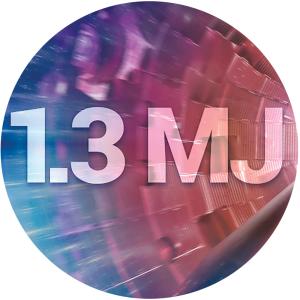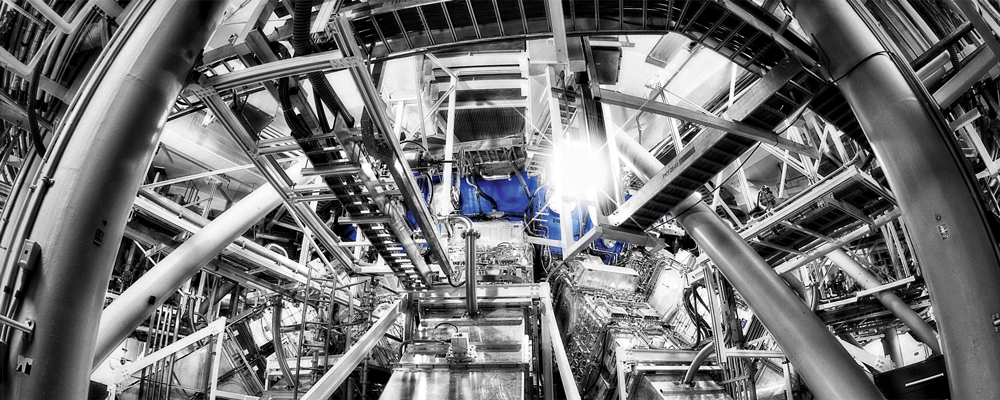Producing 1.3 megajoules(MJ) of fusion energy at the National Ignition Facility(NIF) by imploding a deuterium–tritium (DT) fuel capsule with 1.9 MJ of laser energy
On August 8, 2021, NIF laser beams imploded a target capsule to create a central hot spot of dense DT fuel and trigger a self-sustaining wave of fusion reactions. As defined by the National Academy of Sciences, ignition occurs when the fusion energy produced exceeds the amount of laser energy delivered to the target chamber. The measured fusion yield was about 70 percent of that goal.
A Fusion Energy Breakthrough
The historic experiment conducted at NIF on August 8, 2021, produced 1.3 MJ of fusion energy. Researchers are at the threshold of achieving fusion ignition. The laser system delivered 1.9 MJ of energy, which squeezed the DT fuel within the capsule to 8 times the density of lead and generated more than 10 quadrillion watts of fusion power for 100 trillionths of a second. The fusion yield was 25 times higher than the record set in 2018 and 8 times higher than results achieved earlier in FY 2021.
The efforts in FY 2021 focused on a target design (called Hybrid-E) with a large high-density-carbon (diamond) capsule. Hybrid-E couples more energy to the fuel capsule than the baseline design, compresses it faster, and increases hot-spot pressure and temperature. To achieve a symmetric implosion with the larger capsule, the wavelength of each laser beam is slightly adjusted to help balance x-ray energy that compresses the fuel. This design approach led to higher than previous yields in shots fired in November 2020 (100 kilojoules [kJ]) and February 2021 (170 kJ). For the test in August, the entrance holes that let laser light into the hohlraum (enclosing the target capsule) were reduced in size to increase the coupled energy. To further improve implosion symmetry, the tube that fills DT into the capsule was reduced in diameter from 5 micrometers (µm) to 2 µm and the target fabrication team supplied a much more uniform capsule with 10 times fewer and smaller defects. The result was a dramatic increase in fusion yield.
Success Through Teamwork
This experimental result is a huge step forward for inertial confinement fusion (ICF) research, opening a fundamentally new regime to explore and advance our critical national security mission. Gaining access to thermonuclear burn in a laboratory setting will enable experiments that more rigorously check theory and validate simulations of high-energy-density physics pertinent to weapons performance. Fusion ignition is also an important gateway toward pursuit of high fusion yields, which would be necessary for fusion energy applications.
This significant achievement was made possible by the hard work of the ICF community over many decades and benefited from key advances gained over the last several years. Supporters of the effort include LLNL; industry and academic partners; and collaborators at Los Alamos National Laboratory, Sandia National Laboratories, the University of Rochester’s Laboratory for Laser Energetics (LLE), and General Atomics. The achievement builds on the work of the entire team, including the people who pursued and advanced ICF research since the Laboratory’s earliest days.
Founding of the ICF Program
In the late 1950s, Laboratory physicist (and later Director) John Nuckolls and colleagues ran the latest computer codes and found that radiation could implode a capsule of DT fuel and initiate a very small-scale fusion explosion. At about the same time, Theodore Maiman built the first laser, and laser experiments began at the Laboratory soon after. In 1971, Associate Director at Large Carl Haussmann took charge of a newly created Laser Program; proposed to the Atomic Energy Commission (AEC) the construction of a high-power, solid-state 10-kJ laser; and recruited John Emmett to the Laboratory to lead the AEC-approved, 20-beam Shiva laser project. Experiments using Shiva made clear that shorter wavelength laser light would be necessary, and experiments at LLE demonstrated a way to triple laser-light frequency. Construction of the next large laser, the 10-beam Nova laser, began in 1979, and in the 1980s, experiments at Nova and underground ICF nuclear tests uncovered no showstoppers to achieving ignition with a larger laser.
The Giant Step to NIF
From a technology point of view, NIF was a giant step. The 60-fold increase in laser capability required significant advances in laser architecture and many other technologies including optical materials (see the box below) as part of a multibillion-dollar construction project. In recommending that NIF be built at an energy of about 2 MJ, the National Academy of Sciences expected that the probability of achieving ignition would be at best a 50-50 proposition. Yet, it was appropriate as a next step toward ignition and a vital component of the Stockpile Stewardship Program.
The initial ignition campaign began the long process of bringing into operation improved diagnostics, developing experimental platforms, increasing the damage resistance of optics, and discovering and overcoming barriers to achieving ignition. With the high-foot campaign launched in 2013, researchers experimented with a laser-pulse shape to obtain more stable implosions and first demonstrated alpha heating. A systematic process of identifying and overcoming implosion deficiencies ensued, accelerated progress, and led to hybrid target capsule designs and the successes that bring the ICF community to the doorstep of ignition.
The Seven Wonders of NIF
NIF team scientists, engineers, and technicians had to overcome a daunting array of technical issues. Working closely with industrial partners, they found solutions for precision preamplifier modules and addressed challenges in continuous-pour laser glass, rapid-growth crystals, and coatings and finishing techniques for optical switches and deformable mirrors to withstand extremely high energies. The team also worked with vendors to develop pulsed-power electronics, innovative control systems, and advanced manufacturing capabilities for target fabrication.








